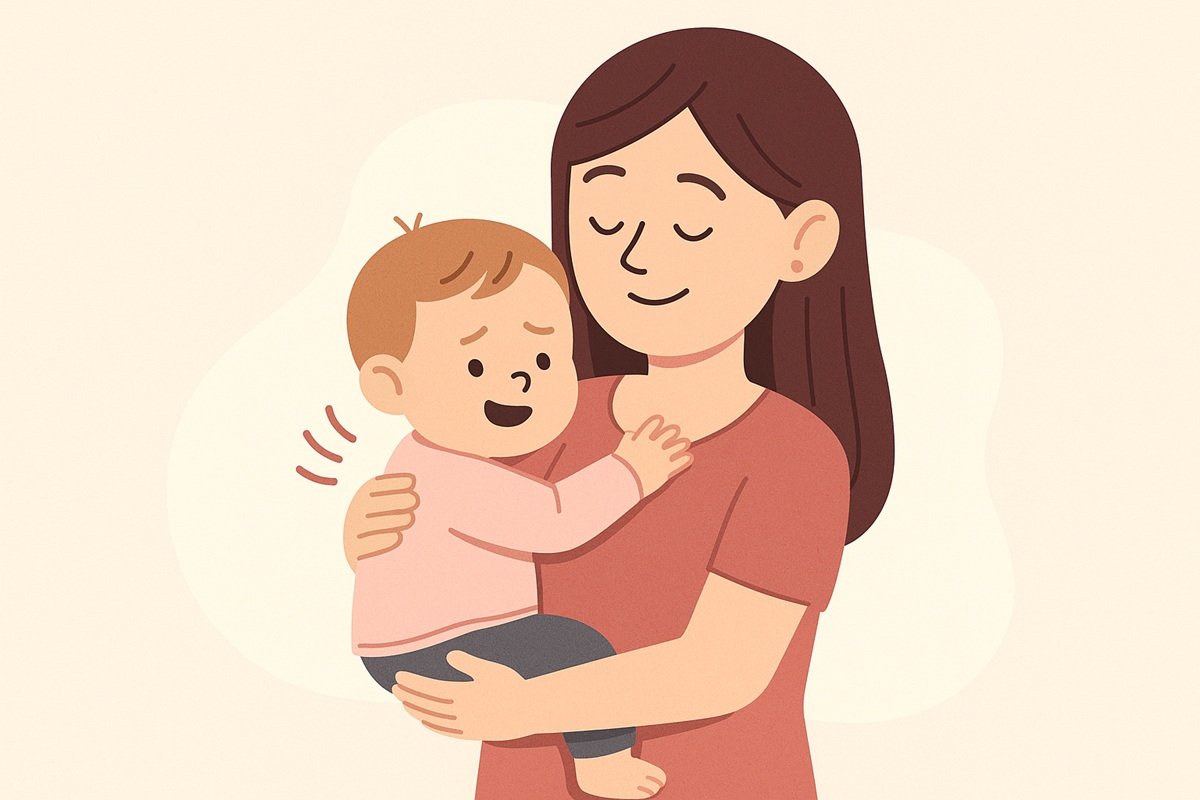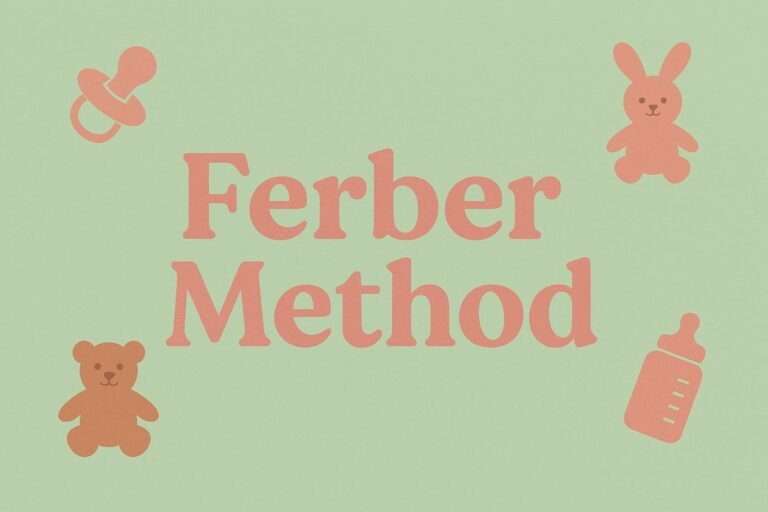As I watch my younger son (who is already 7) cling to me for the fifth time in an hour while I attempt to load the dishwasher, I’m reminded that some babies simply need more physical connection than others. If you’ve found yourself with a little one who seems permanently attached to you – crying when you dare to put them down even for a moment – you’re not alone. You have what many parents affectionately – and sometimes exhaustedly – call a Velcro baby.
In my 12 years of parenting experience and countless conversations with other parents, I’ve discovered that the Velcro baby phenomenon is both common and incredibly challenging. While these babies offer an abundance of snuggles and close connection, they can also leave you feeling touched out, overwhelmed, and wondering if you’ll ever be able to shower alone again.
In this guide, I aim to explore what makes a Velcro baby, how to understand their needs, and most importantly – what practical strategies can help both you and your baby thrive during this intense but temporary stage.
Table of Contents
What Is a Velcro Baby?
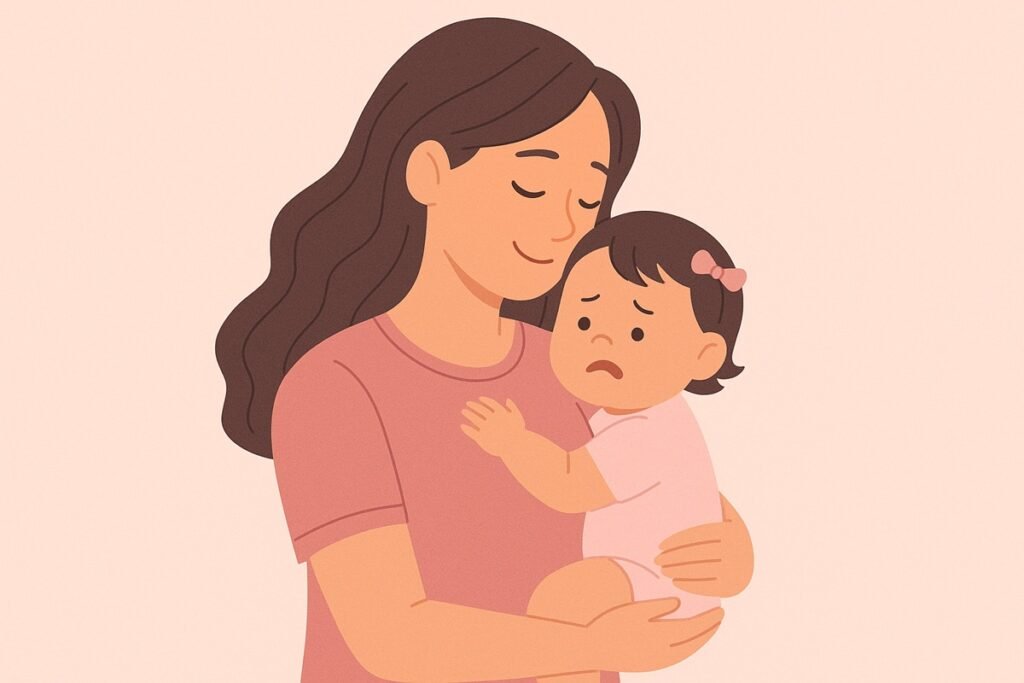
A Velcro baby is a parenting term used to describe infants who strongly prefer to be held, carried, or physically close to their caregivers, especially mom, most of the time. These babies often become immediately distressed when put down, even after being fed, changed, and seemingly content. They may only nap while being held and might cry inconsolably when separated from their preferred caregiver.
As you can imagine, the term Velcro baby comes from the image of these little ones sticking to you like Velcro – they want constant physical contact and proximity, and they make their preferences known loudly and clearly!
While some parents worry that this extreme clinginess might indicate that something is wrong with their kid or might be the result of overly permissive parenting, child development experts have a different perspective. According to therapists and attachment specialists, what we call clinginess is actually a sign of healthy, secure attachment. Babies tend to act like Velcro because of them this secure attachment forms the foundation for growing and developing in a healthy way.
Research on attachment shows that this secure bond is exactly what babies need for healthy development. According to a study from Princeton University, approximately 60% of children develop secure attachments to their parents, formed through responsive caregiving such as holding a baby and responding to their needs. Children who are raised through secure attachments grow to be resilient to challenges such as family stress, poverty, and parental depression.
The remaining 40% of children may have various degrees of insecure attachments. So, your clingy baby is actually showing signs of feeling securely attached to you! While that perspective might not make the daily challenges easier, it may help you appreciate that your baby’s clinginess is actually a positive sign of their development.
Velcro Baby vs Bubble Baby
Not all babies exhibit the same attachment behaviors. In fact, baby temperaments can vary dramatically, with some babies seeming to be at the opposite end of the spectrum from Velcro babies.
What Is a Bubble Baby?
A bubble baby is essentially the opposite of a Velcro baby – these little ones are more independent and less physically clingy. The term originates from the idea that these babies are impossible to catch with your hands, just like bubbles. In other words, they don’t need – or might not even like – to be constantly held and caressed.
Similarities between Velcro and Bubble Babies:
- Both temperament types are normal and healthy.
- Both can form secure attachments with caregivers.
- Both need responsive parenting tailored to their needs.
- Both may go through phases of different behavior as they develop.
- Both benefit from consistent routines and boundaries.
Differences between Velcro and Bubble Babies:
- Velcro babies seek constant physical contact, while bubble babies are more comfortable with independent exploration.
- Velcro babies often protest being put down, whereas bubble babies may be content playing alone.
- Velcro babies may struggle with separation, and bubble babies often transition more easily.
- Velcro babies typically prefer one primary caregiver, while bubble babies may be more flexible.
- Velcro babies may be more sensitive to environmental changes, whereas bubble babies often adapt more easily.
Interestingly, some babies may start as Velcro babies and transform into bubble babies as they develop. This transition usually happens as they gain confidence, motor skills, and a more secure understanding that caregivers will return after separation.
Personal experience: In my case, the opposite happened. My younger son Jude was a much more independent baby than my older son Adam. Jude used to like spending some time playing on his own as a baby and falling asleep on his own, while Adam always had to be carried to fall asleep. However, the Coronavirus pandemic started when Jude was about 2.5 years old, the company where I worked at the time switched to working from home, Adam’s school switched to online studying, and Jude – who was attending kindergarten at the time – simply stayed home. That’s when Jude’s Velrco-ness developed. We spent the first year of the pandemic with him sitting on my lap while I was typing on the laptop. Now, 5 years later, he’s become much better, but he still remains much more physically attached to me than Adam was at his age.
In any case, it’s important to remember that neither type – Velcro baby or bubble baby – is better than the other; they’re simply different temperaments that require different parenting styles. The goal isn’t to change your baby’s inherent nature but to support them through their developmental stages in ways that help them feel secure.
What Is Making Your Baby So Clingy?
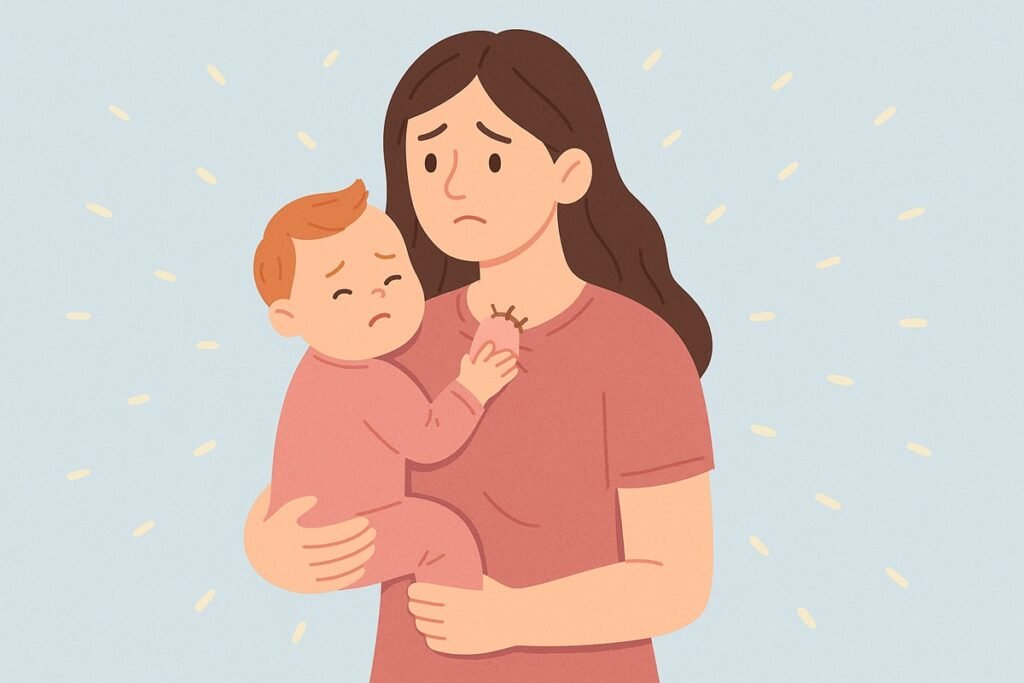
While some babies are naturally more prone to clinginess based on their character, there are common factors that can contribute to or intensify Velcro baby behavior.
The most popular triggers of this stage include:
1. Secure Attachment Development
Contrary to some assumptions, clingy babies behavior is actually a sign of healthy attachment development. Experts point out that clinginess is usually absolutely normal and is simply a sign of the strong love that your baby feels for you. Babies who feel securely attached use physical proximity to their caregivers as a secure base from which to gradually explore the world.
2. Developmental Milestones
Many babies become clingier around significant developmental milestones. As they learn new skills like crawling or walking, they may seek more reassurance and connection. This is particularly common around 8-10 months when babies develop object permanence – understanding that people and things exist even when they can’t see them.
3. Separation Anxiety
Around 8-18 months, many babies develop separation anxiety as a normal part of their cognitive development. As they begin to understand that you exist when out of sight but don’t yet grasp when you’ll return, they may become more clingy to prevent separations.
4. Temperament
Some babies are simply born with more sensitive temperaments. These babies may be more aware of changes in their environment, become more easily stimulated, and have a stronger need for physical contact and reassurance to feel regulated.
5. Changes in Routine or Environment
Babies thrive on consistency and predictability. Major changes such as moving homes, starting daycare, traveling, or even smaller disruptions to their daily routine can trigger increased clinginess as they seek reassurance.
That’s what happened with my son Jude on the onset of the Covid-19 pandemic.
6. Physical Discomfort
Sometimes increased clinginess can signal that your baby isn’t feeling well. Teething, illness, growth spurts, or other physical discomfort may cause your baby to seek more comfort and connection than usual.
7. Maternal Stress or Anxiety
Babies are strongly attuned to their caregivers’ emotional states. If you’re experiencing increased stress, anxiety, or tension, your baby may pick up on these feelings and become clingier in response.
Understanding these potential factors can help you identify what might be contributing to your baby’s clinginess. This awareness allows you to address specific needs rather than simply trying to manage the clinging behavior itself.
How Long Does the Velcro Baby Stage Last?
One of the most common questions parents of Velcro babies ask is: “When will this end?“
While there’s no one-size-fits-all answer, understanding the typical timeline can help you see the light at the end of the tunnel.
The Velcro baby phase most commonly begins in the early months of life, often becoming most pronounced around 6-9 months when separation anxiety naturally develops. For many babies, the intense clinginess peaks between 10-18 months and gradually subsides as they become more confident in their mobility and understanding of the world.
However, each child develops at their own pace. Some Velcro babies may show signs of greater independence by their first birthday, while others maintain their clingy behavior well into their second year.
Research on child development suggests that while the intensity of clinginess typically decreases with age, children who start as Velcro babies often maintain a close emotional connection to their primary caregivers throughout childhood. The good news is that the physically demanding aspect – the inability to put your baby down without protests – does eventually resolve.
What’s considered normal duration for the Velcro baby stage:
- Early clinginess (0-6 months): Normal and beneficial for attachment
- Peak clinginess (6-18 months): Common, especially during separation anxiety phase
- Gradual transition (18-36 months): Increasing independence with occasional clinginess
Signs that might warrant further attention include:
- Extreme distress with any separation after 2 years of age
- Complete inability to interact with other trusted caregivers after 18 months
- Regression to extreme clinginess after a period of independence (without a clear trigger)
- Clinginess accompanied by developmental delays or social engagement concerns
If you’re concerned about your child’s level of attachment or independence, consult with your pediatrician. Most clingy behavior falls within the normal range of development, but a professional healthcare provider can help assess whether additional support might be beneficial.
Disclosure: This post contains affiliate links. As an Amazon Associate, I earn from qualifying purchases. I may earn a commission if you click and make a purchase, at no extra cost to you.
How to Deal with Your Velcro Baby for Their Benefit and Your Sanity: 10 Strategies
Living with a Velcro baby can be physically and emotionally exhausting, but there are strategies that can help both you and your baby thrive during this stage. These approaches honor your baby’s need for connection while helping you maintain your well-being.
Here are a few things to try:
1. Embrace Babywearing
For many Velcro babies, babywearing can be a game-changer. After all, these babies crave to be in physical contact with their mom, and babywearing provides a practical solution for this. Whether you choose a wrap, sling, or structured carrier, wearing your baby around allows you to meet their need for closeness as part of your gentle parenting while keeping your hands free for other activities.
Investing in a comfortable, supportive carrier appropriate for your baby’s age and your body type is worth every penny. Having multiple options (perhaps a quick-and-easy structured carrier for errands and a comfortable wrap for longer wearing sessions) can give you flexibility.
2. Establish Predictable Routines
Babies thrive on predictability. Establishing consistent daily routines helps your Velcro baby feel secure and know what to expect. When babies can anticipate what comes next, they often feel less need to cling for security.
Try creating visual or verbal cues to signal transitions in your routine. For example, singing a specific song before naptime or using the same phrases when you need to put your baby down can help them adjust to brief separations.
3. Practice Small Separations
Gradually introducing your baby to brief, positive separations can help build their confidence. Start by putting them down with an engaging toy while staying within their sight. Slowly increase the distance and duration as they become more comfortable.
The idea is to start small in order to show your baby that being alone – or at least without you – is OK and that you will be back. This helps overcome the sense of anxiety that some babies feel even with very short separation from their main caregiver.
4. Involve Other Caregivers
Remember: “It takes a village to raise a child.”?
While Velcro babies typically prefer their primary caregiver, gradually introducing other trusted adults can provide much-needed relief. Start with short periods where another caregiver interacts with your baby while you remain nearby, and then gradually increase the duration of these interactions.
Be patient with this process. It may take multiple attempts before your baby becomes comfortable with other caregivers. The investment is worth it for both your sanity and your baby’s social development.
5. Create a “Yes” Space
Designate a completely baby-proofed area where your little one can safely explore without constant supervision. This might be a gated play area with age-appropriate toys and no hazards. When you need a moment to yourself, knowing your baby is in a safe space can reduce your stress.
For Velcro babies, transition to independent play in this space gradually. Start by sitting with them, then slowly move to the edge of the space while still engaging, and eventually step away for brief periods while remaining visible.
6. Use Familiar Objects for Comfort
Some Velcro babies find comfort in objects that carry their caregiver’s scent. A T-shirt you’ve worn or a small lovey that smells like you can sometimes provide reassurance when you need to put your baby down.
For older babies (12+ months), introducing a transitional object like a special stuffed animal or blanket can help them feel connected to you even when you’re not physically present.
Personal experience: Once my son Jude started recovering from the initial shock of the pandemic and started separating from me once again more easily, he got attached to a little stuffed raccoon – Oaklet (who’s become the main character of my series of children’s books Oaklet The Little Raccoon). Oaklet has been following us everywhere we go – whether shopping, eating out, or traveling abroad. I believe that Oaklet has played an instrumental role in helping me restore some of my sanity.
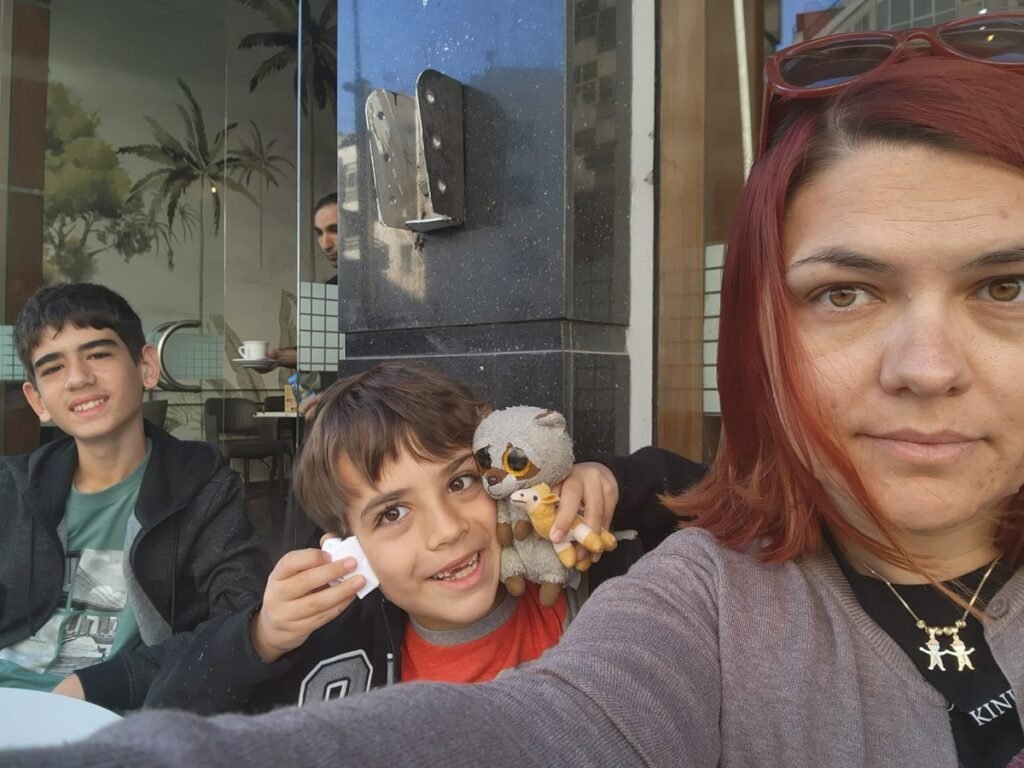
7. Prioritize Self-Care in Small Doses
Finding time for self-care with a Velcro baby requires creativity and often means embracing smaller moments rather than extended breaks. Look for opportunities during naps (even if they’re short), after bedtime, or when another caregiver can take over.
Even five minutes of deep breathing, a quick shower, or enjoying a hot drink without multitasking can help restore your energy. Remember that taking care of yourself isn’t selfish – it’s essential for being able to meet your baby’s needs.
8. Consider Your Baby’s Sleep Environment
Many Velcro babies struggle with sleep separations. Creating a sleep environment that helps them feel secure can make a significant difference. This might include using a sound machine for consistent background noise, maintaining a predictable bedtime routine, or considering safe co-sleeping options if appropriate for your family.
Some parents find that a gradual approach to independent sleep works best with Velcro babies. This might mean starting with contact naps and bedsharing, then slowly transitioning to sleeping beside but not touching the baby, and eventually moving to separate sleep spaces.
9. Find Your Village
Socializing is extremely important for new moms, especially those dealing with Velcro babies. That’s why you should actively look for a mommy and me class, a nearby mothers support group, or other fellow moms that you can hang out with while holding on to your baby on a regular basis.
Connecting with other parents of Velcro babies can provide both practical support and emotional validation. Look for local parenting groups, online communities, or classes specifically designed for parents and babies to attend together.
10. Remember This Is Temporary
When you’re in the thick of the Velcro baby stage, it can feel never-ending. Remind yourself regularly that this phase – though intense – is temporary. The same child who refuses to be put down now will eventually become an independent explorer and even a teenager who wants nothing to do with you.
Actually, many parents of older children look back on the Velcro baby days with nostalgia for the closeness, even as they celebrate their child’s growing independence. So, remember to cherish these moments though they feel tough at the moment – each day with your little one is unique, and you’ll never have it back again.
3 Best Books for Parents of Velcro Babies
When navigating the challenges of a Velcro baby, knowledge truly is power. The right resources can provide validation, practical strategies, and a deeper understanding of your baby’s needs.
Following are 3 outstanding parenting books that have helped countless parents through this demanding but rewarding stage:
1. The Attachment Parenting Book: A Commonsense Guide to Understanding and Nurturing Your Baby by William Sears, MD, and Martha Sears, RN
This foundational text by the couple who coined the term attachment parenting provides essential insights for parents of clingy babies. The Sears present their philosophy through the Baby B’s: Birth bonding, breastfeeding, babywearing, bedding close to baby, belief in the language value of your baby’s cry, beware of baby trainers, and balance.
What makes The Attachment Parenting Book particularly valuable for parents of Velcro babies is its emphasis on responding to your baby’s needs while maintaining your own well-being. The authors, drawing from both their professional expertise and experience raising eight children, validate that your baby’s desire for closeness is healthy and normal. They offer practical advice for managing the demands of a clingy baby without compromising your sanity or your child’s attachment needs.
2. Raising a Secure Child: How Circle of Security Parenting Can Help You Nurture Your Child’s Attachment, Emotional Resilience, and Freedom to Explore by Kent Hoffman, Glen Cooper, and Bert Powell
Based on decades of attachment research and clinical work, this book introduces the Circle of Security approach, which helps parents understand the emotional needs behind their child’s behavior. For parents of Velcro babies, this framework is invaluable for recognizing that clingy behavior is your child’s way of communicating important needs.
In Raising a Secure Child, the authors explain how to provide a secure base from which your child can explore and a safe haven to which they can return when needed. This balanced approach helps parents respond effectively to clingy behavior while gradually encouraging independence. The book includes self-assessment tools to identify your own attachment patterns and how they might influence your parenting, which is particularly helpful when feeling frustrated with a clingy baby.
3. The Wonder Weeks: A Stress-Free Guide to Your Baby’s Behavior by Hetty van de Rijt, PhD, and Frans Plooij, PhD
Unlike the other two recommendations, this book takes a developmental approach rather than focusing specifically on attachment. It provides invaluable insights for the parents of a Velcro baby by explaining the predictable developmental leaps that often trigger clingy behavior.
By understanding that your baby’s increased neediness often coincides with cognitive development leaps, you can reframe these challenging periods as positive signs of growth. The Wonder Weeks details 10 major developmental leaps during the first 20 months and provides specific strategies for supporting your baby through each one. Many parents report that knowing when to expect more clingy behavior – and that it will pass – makes the Velcro baby stage much more manageable.
Final Thoughts
Parenting a Velcro baby brings unique challenges along with special opportunities for connection. While the constant physical demands can be exhausting, understanding that your baby’s clinginess is actually a sign of healthy attachment can help shift your perspective from frustration to appreciation.
The strategies we’ve explored – from practical solutions like babywearing to emotional approaches like embracing the temporary nature of this stage – can help you navigate the Velcro baby phase with greater ease and confidence. Remember that you’re not alone in this experience, and seeking support from other parents, family members, or professionals is both wise and necessary.
As your Velcro baby gradually develops more independence, you’ll likely find that the secure attachment you’ve fostered through responsive caregiving creates a foundation for a confident, emotionally healthy child. The intense physical connection of babyhood evolves into a strong emotional bond that will serve both of you well throughout your relationship.
Have you experienced life with a Velcro baby? What strategies helped you navigate this challenging but rewarding stage? What did you find most difficult about having a Velcro baby? Other parents and I would love to hear your experiences in the comments below!

